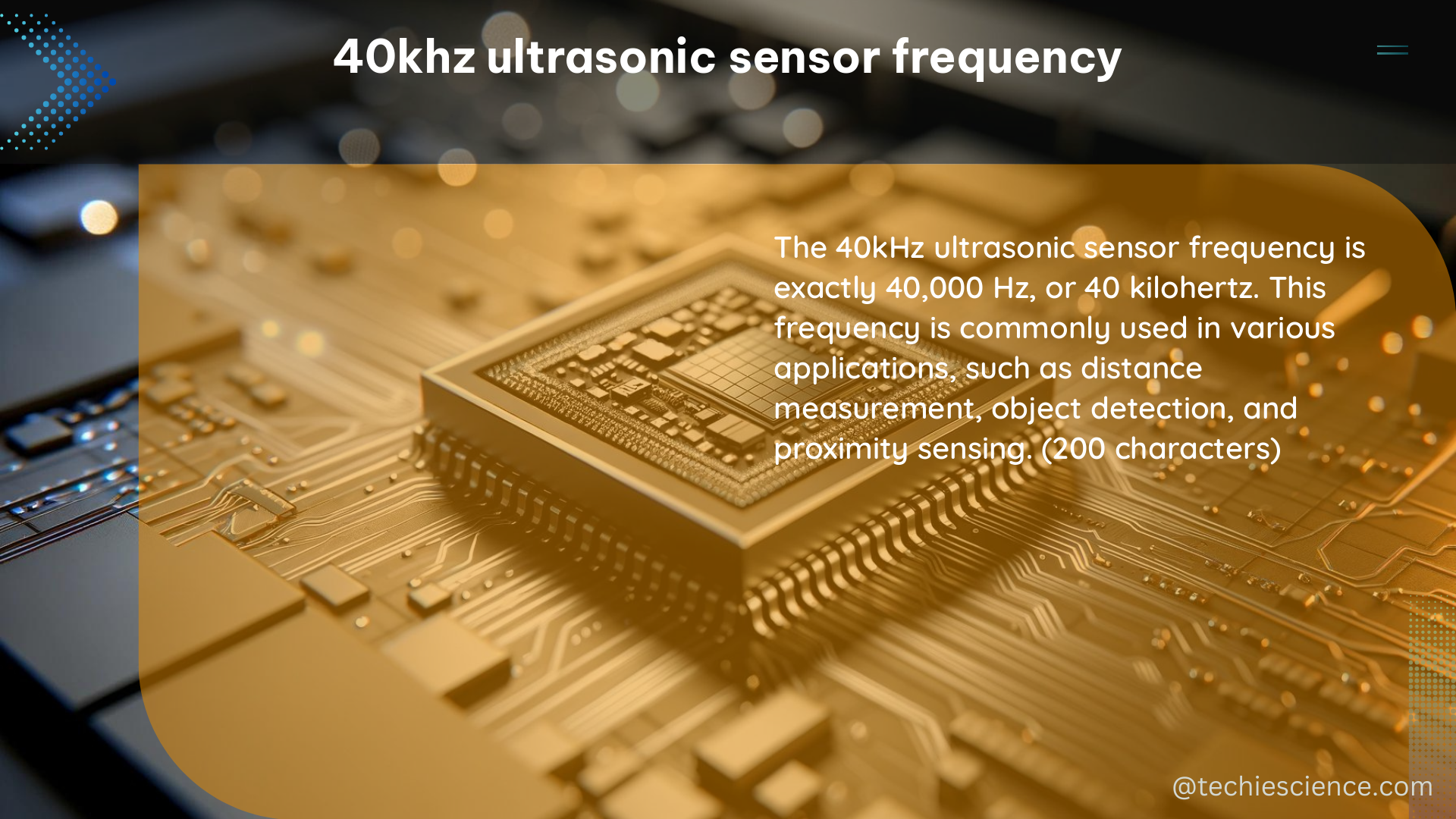The 40kHz ultrasonic sensor frequency is a widely used technology in the field of distance measurement, object detection, and fluid level monitoring. This frequency range offers several advantages, including good penetration through various materials and the ability to accurately measure distances up to several meters.
Understanding the Technical Specifications of 40kHz Ultrasonic Sensors
A 40kHz ultrasonic sensor typically has the following technical specifications:
- Frequency Range: The sensor operates at a center frequency of 40kHz, with a typical frequency tolerance of ±1kHz.
- Detection Range: The sensor can detect objects within a range of 0.2 to 5 meters, depending on the specific model and environmental conditions.
- Beam Angle: The sensor’s ultrasonic beam has a typical beam angle of 15-30 degrees, allowing for a focused and directional detection pattern.
- Resolution: The sensor can typically resolve distance measurements with a resolution of 1-2 millimeters.
- Accuracy: The sensor’s distance measurement accuracy is typically within 1-2% of the measured distance, depending on factors such as target material, temperature, and humidity.
- Response Time: The sensor can provide distance measurements with a response time of 50-100 milliseconds, allowing for real-time monitoring and control applications.
- Power Supply: 40kHz ultrasonic sensors typically operate on a 5V or 12V DC power supply, with a current consumption of 15-30 mA.
Factors Affecting the Performance of 40kHz Ultrasonic Sensors

The performance of 40kHz ultrasonic sensors can be influenced by several environmental and operational factors:
- Temperature: The speed of sound in air varies with temperature, which can affect the accuracy of distance measurements. Sensors often include temperature compensation algorithms to mitigate this effect.
- Humidity: Changes in humidity can also impact the speed of sound, leading to potential measurement errors. Sensors may incorporate humidity compensation to maintain accuracy.
- Target Material: The reflectivity and absorption characteristics of the target object can influence the strength of the reflected ultrasonic signal, affecting the sensor’s detection range and reliability.
- Interference: Other ultrasonic sources, such as nearby sensors or high-frequency noise, can interfere with the sensor’s operation, leading to false readings or reduced detection range.
- Mounting Orientation: The sensor’s mounting position and angle can impact the detection pattern and the accuracy of distance measurements, especially in applications with complex geometries or multiple targets.
Practical Applications of 40kHz Ultrasonic Sensors
40kHz ultrasonic sensors find a wide range of applications in various industries and sectors:
- Distance Measurement: These sensors are commonly used for measuring the distance to objects, such as in robotics, automation, and industrial process control.
- Object Detection: 40kHz ultrasonic sensors can be used to detect the presence, position, and movement of objects, making them useful in applications like security systems, material handling, and collision avoidance.
- Fluid Level Monitoring: Ultrasonic sensors operating at 40kHz can be used to monitor the level of liquids in tanks, containers, and other vessels, finding applications in water treatment, chemical processing, and industrial automation.
- Proximity Sensing: 40kHz ultrasonic sensors can be used for proximity detection, enabling applications such as automatic door opening, gesture recognition, and touch-less user interfaces.
- Non-Contact Measurement: Ultrasonic sensors can perform non-contact measurements, making them suitable for applications where physical contact with the target is undesirable or impractical, such as in harsh environments or moving parts.
Integrating 40kHz Ultrasonic Sensors into DIY Projects
For DIY enthusiasts and hobbyists, 40kHz ultrasonic sensors offer a versatile and accessible solution for a variety of projects. Here are some steps to consider when integrating these sensors into your DIY projects:
- Sensor Selection: Choose a 40kHz ultrasonic sensor that meets your project’s requirements in terms of detection range, beam angle, accuracy, and power supply.
- Circuit Design: Develop a simple circuit to power the sensor and interface it with a microcontroller or single-board computer, such as an Arduino or Raspberry Pi.
- Sensor Mounting: Carefully position and mount the sensor to ensure optimal performance, considering factors like target distance, sensor orientation, and potential interference sources.
- Firmware Development: Write firmware or software to control the sensor, read its data, and process the measurements for your specific application, such as distance monitoring, object detection, or fluid level tracking.
- Calibration and Tuning: Calibrate the sensor’s performance by adjusting parameters like sensitivity, detection thresholds, and compensation algorithms to account for environmental factors and ensure reliable operation.
- Troubleshooting and Optimization: Continuously monitor the sensor’s performance, diagnose any issues, and make necessary adjustments to optimize the system for your DIY project.
Conclusion
The 40kHz ultrasonic sensor frequency is a versatile and widely used technology in the field of sensing and measurement. By understanding the technical specifications, factors affecting performance, and practical applications of these sensors, DIY enthusiasts can successfully integrate them into a wide range of projects, from distance measurement and object detection to fluid level monitoring and proximity sensing. With the wealth of online resources and communities available, DIY enthusiasts can explore the full potential of 40kHz ultrasonic sensors and create innovative solutions for their projects.
References
- Process Control in Food Processing
- MoH_Framework Agreement Tender_Purchase (2)
- High Pressure Processing for Foods Preserving

The lambdageeks.com Core SME Team is a group of experienced subject matter experts from diverse scientific and technical fields including Physics, Chemistry, Technology,Electronics & Electrical Engineering, Automotive, Mechanical Engineering. Our team collaborates to create high-quality, well-researched articles on a wide range of science and technology topics for the lambdageeks.com website.
All Our Senior SME are having more than 7 Years of experience in the respective fields . They are either Working Industry Professionals or assocaited With different Universities. Refer Our Authors Page to get to know About our Core SMEs.